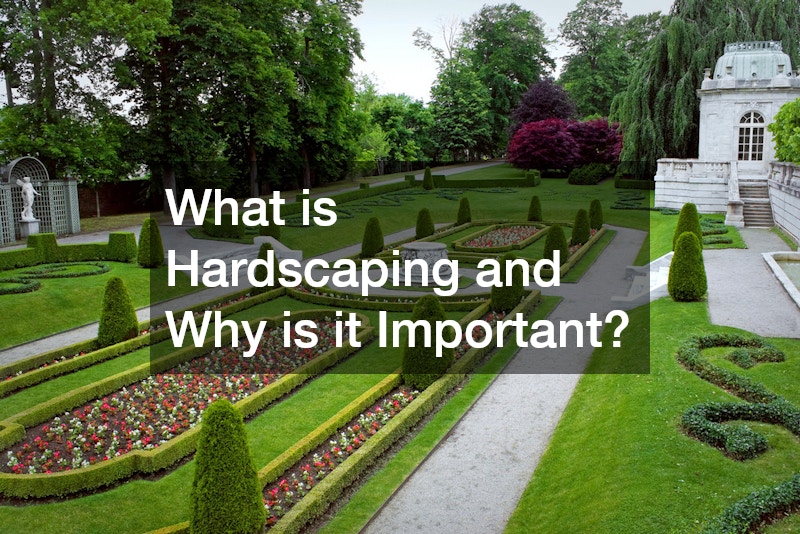
Hardscaping refers to the non-plant elements that are incorporated into a landscaping design. This includes structures like patios, walkways, retaining walls, and other landscaping features made from hard materials such as stone, brick, or concrete. While many homeowners focus on the planting and greenery aspects of their outdoor spaces, hardscaping plays a crucial role in creating functional and aesthetically pleasing environments.
Video Source
Understanding hardscaping and its importance can help homeowners make informed decisions about their landscaping projects. Through both beauty and utility, hardscaping is an integral part of any landscape design.
Hardscaping is composed of various elements that serve different purposes in outdoor spaces. The primary components include patios, pathways, decks, fences, and walls. Each of these elements not only adds aesthetic appeal but also enhances the functionality of the space. For instance, patios provide an outdoor living area for relaxation and entertainment. Similarly, retaining walls help control soil erosion while adding design depth to a landscape.
Another key aspect of hardscaping is the use of materials. Common materials for hardscaping include natural stone, pavers, brick, concrete, and gravel. Each material offers its unique advantages, such as durability, ease of maintenance, and visual appeal. Selecting the right materials for hardscaping is vital to achieving the desired outcome in a landscaping project. For example, natural stone provides an organic feel and can blend seamlessly with plants, whereas concrete offers a modern and clean-lined appearance.
Incorporating hardscaping elements also allows homeowners to define distinct areas within their outdoor spaces. These areas can include cozy seating nooks, designated paths for walking, or even areas for gardening or play. By creating these spaces, hardscaping enhances the overall usability of the landscape. Additionally, well-executed hardscaping can increase property value, making it a worthy investment.
One of the primary benefits of hardscaping is its ability to reduce maintenance efforts for outdoor spaces. Unlike plants that require regular watering, trimming, and other care, hardscaping elements are generally low-maintenance. This allows homeowners to enjoy their outdoor areas without the constant upkeep that gardens often demand. For those with busy lifestyles, hardscaping provides a practical solution, offering easy-to-care-for spaces that still look great.
Furthermore, hardscaping can significantly impact the drainage and erosion aspects of a landscape. Properly designed hardscaping can help direct water flow and reduce erosion, which can be beneficial for the health of plants in the surrounding areas. For instance, incorporating gravel pathways can allow rainwater to absorb into the ground rather than causing puddles or flooding. This attention to drainage can greatly improve the long-term viability of a landscape. By investing in solid hardscaping solutions, homeowners can protect their property from potential water damage.
Lastly, hardscaping enhances the aesthetic appeal of a home’s exterior, providing a polished look that complements softscaping elements. Beautifully paved walkways or stylish patios can create a welcoming atmosphere for visitors and residents alike. Beyond just beauty, the integration of hardscaping can increase outdoor usability, allowing for activities such as entertaining guests or enjoying quiet evenings outside. By blending both hardscaping and softscaping, homeowners can create inviting and functional spaces that align with their lifestyles. Ultimately, these benefits underline the importance of hardscaping in any landscaping project.
Integrating hardscaping with landscaping is essential for creating balanced outdoor spaces. When done correctly, hardscaping serves as the framework that supports and enhances the natural elements around it. For example, a beautifully designed stone pathway can guide visitors through a garden, highlighting flowering plants and shrubs along the way. This synergy between hardscaping and landscaping not only improves visual appeal but also directs foot traffic appropriately. Achieving this balance is crucial for maximizing both the aesthetics and functionality of an outdoor area.
One of the effective methods of integrating hardscaping with landscaping is to consider the surrounding environment and house design. Homeowners should strive for a seamless transition between the elements, which can be achieved through color schemes, materials, and styles. For instance, using similar stone textures in both the hardscaping and softscaping can create a cohesive look. It’s also important to maintain proportions; overwhelming a small garden with heavy hardscaping can lead to a cramped feel. Conversely, too little hardscaping in larger spaces may result in underutilized areas.
Overall, successful integration can transform a garden into an outdoor oasis that is both beautiful and usable. Local climate and soil conditions also play a role; some hardscape materials blend better with certain environments than others. Homeowners interested in enhancing their outdoor spaces should consult landscaping professionals to discuss how hardscaping can work alongside plants and trees. Collaboratively, these elements provide a well-rounded outdoor experience that serves personal preferences, functional needs, and aesthetic desires. Thus, the right integration of hardscaping enhances the whole landscaping project significantly.
